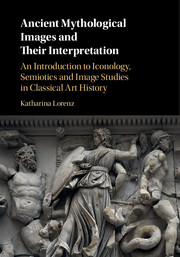 Ancient Mythological Images and their Interpretation
Ancient Mythological Images and their Interpretation Book contents
- Frontmatter
- Dedication
- Contents
- List of figures
- Preface
- The experiment: methods – images – objects
- ICONOLOGY
- SEMIOTICS
- IMAGE STUDIES
- 7 Introducing image studies
- 8 Image studies in action
- 9 Narratives of space and perspective
- 10 The study of mythological images as threesome – assessing the experiment
- Bibliography
- Index
7 - Introducing image studies
from IMAGE STUDIES
Published online by Cambridge University Press: 05 August 2016
- Frontmatter
- Dedication
- Contents
- List of figures
- Preface
- The experiment: methods – images – objects
- ICONOLOGY
- SEMIOTICS
- IMAGE STUDIES
- 7 Introducing image studies
- 8 Image studies in action
- 9 Narratives of space and perspective
- 10 The study of mythological images as threesome – assessing the experiment
- Bibliography
- Index
Summary
‘In each individual case, what is the object of painting? Does it aim to imitate what is, as it is? Or imitate what appears, as it appears? Is it imitation of appearance, or of truth?’
‘Of appearance,’ he said.
‘In that case, I would imagine, the art of imitation is a far cry from truth. The reason it can make everything, apparently, is that it grasps just a little of each thing – and only an image at that. We say the painter can paint us a shoemaker, for example, or a carpenter, or any of the other craftsmen. He may know nothing of any of these skills, and yet, if he is a good painter, from a distance his picture of a carpenter can fool children and people with no judgement, because it looks like a real carpenter.’
Plato, Politeia 598 b–cIn Republic 10, Plato presents his charge against imitation. Socrates is shown embarking on a general discussion of the ‘mimetic’, the imitative arts, touching upon all sorts of visual mimesis. He explains his understanding of imitation by referring to painting, graphike, and painters, zographoi. Painters imitate objects by copying the visual appearance of particular material manifestations of these objects, not their real, truthful being, their form. They capture the surface appearance, to phainomenon, but not the qualitative constituents of whatever they depict – not a real carpenter, but his likeness. Their products are therefore, Socrates argues, ghost-like, phantasmata or eidola, ‘at a third remove from the truth’, the endpoint in the sequence: form – material manifestation – picture.
As Moss has aptly noted, Plato was concerned to characterise the imitative acts as ‘to be compelling and realistic by copying the way things appear, at the cost of misrepresenting the way things are’. This passage has therefore provided an exemplum ex negativo for image studies, whose focus is on precisely what Plato regarded as a deficiency of the visual arts – their removal from truth. Image studies is concerned not with the metaphysics of pictures, their relationship to truth, but with their physics, the way in which they negotiate truth and reality, the stages at a second and third remove from truth.
- Type
- Chapter
- Information
- Ancient Mythological Images and their InterpretationAn Introduction to Iconology, Semiotics and Image Studies in Classical Art History, pp. 169 - 183Publisher: Cambridge University PressPrint publication year: 2016
